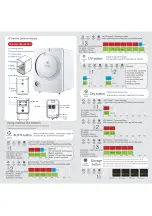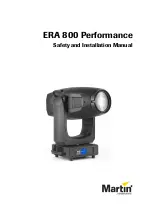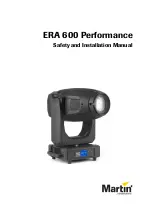
82
Electromagnetic Compatibility Information
Table 1
Guidance and manufacture’s declaration – electromagnetic emissions
The EM 29 is intended for use in the electromagnetic environment specified below.
The customer or the user of the EM 29 should assure that it is used in such an environment.
Emissions test
Compliance Electromagnetic environment – guidance
RF emissions CISPR 11
Group 1
The EM 29 uses RF energy only for its internal function. Therefore, its RF
emissions are very low and are not likely to cause any interference in nearby
electronic equipment.
RF emissions CISPR 11
Class B
The EM 29 is suitable for use in all establishments, including domestic esta-
blishments and those directly connected to the public low-voltage power
supply network that supplies buildings used for domestic purposes.
Harmonic emissions IEC 61000-
3-2
Not appli-
cable
Voltage fluctuations/flicker emis-
sions
IEC 61000-3-3
Not appli-
cable
Table 2
Guidance and manufacturer’s declaration – electromagnetic immunity
The EM 29 is intended for use in the electromagnetic environment specified below. The customer or the user of the EM 29
should assure that it is used in such an environment.
IMMUNITY
test
IEC 60601
test level
Compliance
level
Electromagnetic environment – guidance
Conducted RF
IEC 61000-4-6
Radiated RF
IEC 61000-4-3
3 Vrms
150 kHz to
80 MHz
3 Vrms
80 MHz to
2,5 GHz
3V
3 V/m
Portable and mobile RF communications equipment should be used no
closer to any part of the EM 29, including cables, than the recommended
separation distance calculated from the equation applicable to the frequency
of the transmitter.
Recommended separation distance:
3V
d
= 1,2 x P
1/2
80 MHz to 800 MHz
d
= 2,3 x P
1/2
800 MHz to 2,5 GHz
Where
P
is the maximum output power rating of the transmitter in watts (W)
according to the transmitter manufacturer and
d
is the recommended sepa-
ration distance in meters (m).
Field strengths from fixed RF transmitters, as determined by an electromag-
netic site survey,a should be less than the compliance level in each frequency
range.b
Interference may occur in the vicinity of equipment marked with the following
symbol:
NOTE 1
At 80 MHz and 800 MHz, the higher frequency range applies.
NOTE 2
These guidelines may not apply in all situations. Electromagnetic propagation is affected by absorption and reflec-
tion from structures, objects and people.
a Field strengths from fixed transmitters, such as base stations for radio (cellular/cordless) telephones and land mobile
radios, amateur radio, AM and FM radio broadcast and TV broadcast cannot be predicted theoretically with accuracy. To
assess the electromagnetic environment due to fixed RF transmitters, an electromagnetic site survey should be conside-
red. If the measured field strength in the location in which the EM 29 is used exceeds the applicable RF compliance level
above, the EM 29 should be observed to verify normal operation. If abnormal performance is observed, additional measu-
res may be necessary, such as re-orienting or relocating the EM 29.
b Over the frequency range 150 kHz to 80 MHz, field strengths should be less than 3 V/m.



































